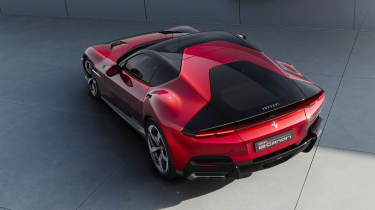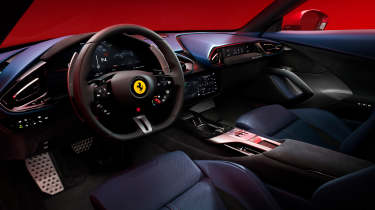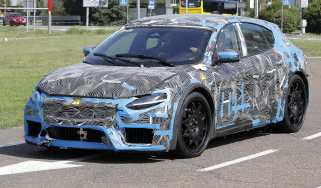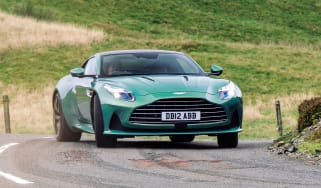The Ferrari 12Cilindri's 'special on demand' paint costs as much as a Golf GTI
Ferrari’s Vanquish-rivalling V12 GT is available to order in the UK, and comes with a £39,624 exterior paint option...
It feels like we’ve been predicting the death of big, naturally-aspirated V12s for years, but noise and emissions regulations haven’t swallowed them up just yet. Meet the new Ferrari 12Cilindri – an 819bhp two-seat GT that replaces the 812 Superfast.
Ferrari knows just how much customers love its 12-cylinder cars (the Purosangue is sold out for years), so it’s jumping through all the necessary legislative hoops to keep them alive – and in the case of the 12Cilindri, make them faster, more exciting and even more dramatic. The new car shares some of its DNA with the ultra-aggressive 812 Competizione, with a design inspired by the iconic 365 GTB/4 Daytona.
Charles Leclerc apparently thought the 12Cilindri was an Icona-series model when he first set eyes on it, and it's hard to spot any visual resemblance to the 812 (the new car even has a 20mm shorter wheelbase thanks to a redesigned aluminium chassis). According to Ferrari engineers, the goal has been to blend the sharpness of the 812 Competizione with the GT qualities of the Superfast, made possible by overhauled chassis and software systems throughout the car.
The 12Cilindri is also being offered as a convertible at launch, with the Spider version using an 812-derived folding hardtop. The coupe comes in at £336,500, with the Spider costing £366,500. As ever, the base price can quickly rise after ticking a few options – particularly if you go for Ferrari's £39,624 'special colour on demand' paint option...
Engine
A 6.5-litre V12 – codenamed F140HD – is the centrepiece of the 12Cilindri. A peak output of 819bhp and a 9500rpm rev limit put it right in line with the 812 Competizione’s motor (torque is slightly down at 500lb ft), which has been achieved through lighter internals and revised intake tracts with optimised cam profiles to suit. The crank is 3 per cent lighter than before, the conrods are titanium and the pistons are made from a different aluminium alloy, all of which enables the V12 to spin faster on its way to a 211mph+ top speed. As in the Superfast, 62mph comes up in 2.9sec.
Gearbox
Out goes the 812’s seven-speed dual-clutch, in comes the eight-speeder from the SF90 and 296 GTB. The 12Cilindri can shift 30 per cent faster than its predecessor (which is hard to comprehend if you’ve driven an 812), and benefits from shorter ratios in the lower gears for more punch and urgency. The new ‘box also helps deliver a 12 per cent increase in torque at the wheels, and on the software side, Ferrari has manipulated the torque curve of the engine in third and fourth gears to give the sensation of continuous, never-ending acceleration. A similar solution has been used in its turbocharged models to mimic the crescendo of a naturally-aspirated engine.
Chassis
The basis for the 12Cilindri is an all-aluminium chassis that’s 15 per cent stiffer than that of the Superfast, and 20mm shorter in wheelbase. Despite this, the new car is 35kg heavier than its predecessor at 1560kg (dry); the Spider version, unveiled alongside the coupe, gets strengthened sills and carries a further 60kg weight penalty. There are significant advancements elsewhere, though, including the fitment of a Competizione-derived rear-steer system which turns each rear wheel independently to aid stability and responsiveness. This works with suspension hardware developed from the 812, with calibration settings closer to those of the Competizione to deal with the 12Cilindri’s higher cornering potential.
Wheels, tyres and brakes
Two tyre options – a Michelin Pilot Sport S5 and Goodyear Eagle F1 Supersport – have been developed in specific sizes for the 12Cilindri’s 21-inch wheels, measuring 275-section at the front and 315 at the rear. The new compounds offer improved stability in dry and wet conditions, as well as a 10 per cent reduction in rolling resistance compared to previous technology. Behind the wheels, you’ll find the same size braking package as the 812, albeit with a new pad compound and a brake-by-wire connection to the pedal. According to Ferrari, this allows for a more consistent feel underfoot, and the introduction of the firm’s ABS Evo system makes more effective use of available tyre grip under heavy braking.
Electronics
We wouldn’t be surprised if the 12Cilindri could lap Fiorano all by itself, such is the complexity of the electronics onboard. Alongside the aforementioned ABS Evo system, it gets Ferrari’s latest Side Slip Control 8.0 to monitor and maximise the car’s performance. This works using a new 6w-CDS sensor to accurately determine the car’s cornering attitude, subtly smoothing out the driver’s inputs to work each contact patch to the limit. These electronics are a big part of why, according to Ferrari’s product development boss Gianmaria Fulgenzi, the 12Cilindri feels ‘10 or 15 years newer’ than the 812 from behind the wheel.
Aerodynamics
In traditional Ferrari fashion, the 12Clinidri primarily uses its floor to generate downforce, rather than large splitters and fixed wings on the outer bodywork. Three pairs of vortex generators at the front of the floor are balanced out by another pair at the rear to energise air flowing under the car, working together with the rear diffuser. The 12Cilindri has a trick up its sleeve in the form of two Pagani Huayra-style rear wing flaps, which sit flush with the bodywork until 37mph. Beyond this point, they deploy in response to the cornering, acceleration and braking forces, adding 50kg of downforce at 155mph .
Interior
You’ll recognise most of the 12Cilindri’s cabin from the Purosangue – and yes, that does include the touch displays and haptic steering wheel buttons for the main controls. Unlike in Ferrari’s (not an) SUV, the primary display is located in the centre of the dash, which is split into two pod-like sections for the driver and passenger. The co-driver gets their own 8.8-inch screen to look at speed, engine revs and other information, and if you aren’t a fan of Ferrari’s HMI system, you can hook up your smartphone via Apple CarPlay or Android Auto instead.
Price and rivals
The 12Cilindri costs from £336,500 in the UK, putting it right in line with another 800bhp+ V12 GT: the new Aston Martin Vanquish. Aston has gone to great lengths to make the Vanquish look, feel and drive like a bespoke product rather than a V12-engined DB12, and it gets a unique carbonfibre body, a comprehensively reworked chassis and an 824bhp twin-turbo V12. What Aston doesn't offer (for now at least) is the option of an open-top Volante version, so if you want a V12 GT without a roof, the 12Cilindri Spider has you covered for £366,500.
The average 12Cilindri customer is predicted to spend below £430,000 on their car with options included. Being a Ferrari, the 12Cilindri's option list is extensive, with an enormous variety of equipment, trim finishes and carbonfibre elements to choose from – some of which cost eye-watering sums. Want your 12Cilindri in a unique 'special' paint colour? That'll be £39,624, or about the same as a brand new Golf GTI.
First deliveries of left-hand drive examples are scheduled for Q4 this year, with right-hand drive cars coming later.










